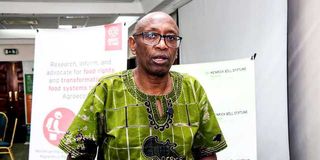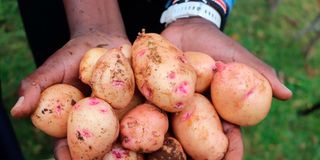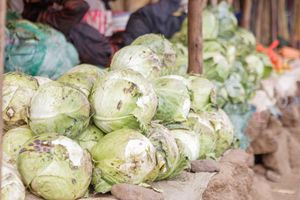
Dr Warui speaking during the launch of Soil Atlas Kenya 2025 on February 27, 2025.
What is the current state of soils in Kenya?
According to the Soil Atlas, over 40 per cent of East Africa’s soils are degraded, with Kenya losing 26 tonnes of soil per hectare annually due to erosion. Additionally, 40 percent of Kenya’s irrigated land is affected by salinisation, further reducing arable land. Key factors contributing to this situation include soil erosion driven by deforestation, unsustainable farming practices and climate change.
According to the United Nations Convention to Combat DesertificationUNCCD (2017), soil degradation costs Kenya billions in lost productivity, affecting food security, rural livelihoods and national economic stability.
What are some of the causes of land degradation in the country?
Historically, fertile lands in Kenya have degraded due to multiple factors, including deforestation and unsustainable land use patterns.
For instance, clearing forests for agriculture disrupts soil structure and increases erosion. Another factor is intensive farming without soil conservation that entails repeated cultivation, which depletes soil nutrients and weakens soil integrity.
Also, overgrazing exposes soils to erosion, not forgetting land grabbing and large-scale farming whereby the Soil Atlas report describes how land acquisitions displace traditional farmers, leading to soil depletion. Also to consider is salinisation, poor irrigation practices, increasing droughts and floods.
Outline some of the parameters that should be considered in classification of soils.
Soils are classified based on physical, chemical and biological properties, including, texture (sand, silt, clay proportions).
Structure, how soil particles are arranged, Soil pH, which describes acidity or alkalinity, nutrient content (nitrogen, phosphorus, potassium levels), drainage capacity (water retention and permeability) and organic matter content, which is critical for fertility and microbial life .
In favour of plant growth, what are the characteristics of fertile soils?
For farming to be profitable and sustainable, soil must support optimal plant growth, efficient nutrient cycling and resilience to environmental stressors.
This requires a balance of physical (structure), chemical (nutrients, pH) and biological (microbial activity) properties. Soil structure plays a critical role in root development, water retention and aeration.
Also Read: Future of our agriculture lies in science
Well- aggregated soils with a loamy texture provide the best conditions for crops, allowing for proper drainage while retaining sufficient moisture.
Compacted soils, however, restrict root penetration and limit nutrient uptake, reducing yields. Equally important is soil chemistry, particularly nutrient balance and pH levels. This has been the focus in most soil tests.
Most crops thrive in a pH range of 5.5 to 7.0, but soil acidity or alkalinity can affect nutrient availability. Acidic soils, common in many farming regions, may require lime to neutralise acidity, while overly alkaline soils can lead to micronutrient deficiencies.
The availability of essential nutrients like Nitrogen (N), Phosphorus (P), and Potassium (K) determines plant health, and imbalances can severely impact productivity.
Additionally, Cation Exchange Capacity (CEC) influences the soil’s ability to retain and release nutrients, making organic-rich and clayey soils more fertile than sandy soils, which tend to lose nutrients quickly.

Dr Warui speaking during the launch of Soil Atlas Kenya 2025 on February 27, 2025.
Beyond structure and chemistry, soil biology is a crucial yet often overlooked factor in farm productivity. Healthy soils contain a diverse range of beneficial microbes, fungi, and earthworms that enhance nutrient cycling and organic matter decomposition.
Also, nitrogen-fixing bacteria, such as rhizobium, improve soil fertility by converting atmospheric nitrogen into forms plants can absorb, while mycorrhizal fungi help crops access phosphorus.
The presence of organic matter, including decomposed plant material and manure, not only enriches the soil, but also boosts microbial activity, enhancing its long-term productivity.
Recently, you launched the Soil Atlas, Kenya Edition. Take us through the publishing journey.
The Soil Atlas was developed through a rigorous, expert-driven process that brought together leading scientists, practitioners, and policymakers to compile and analyse critical information on soil health, land use and degradation trends. Each chapter or section was authored by specialists in the field, ensuring that the content is scientifically accurate, contextually relevant, and grounded in the realities of soil management in the region
Who are you targeting in the publication?
The Soil Atlas is designed for farmers, to educate them on soil health and sustainable practices.
It also targets policymakers who shape agricultural policies and land governance, as well as researchers who support scientific studies on soil conservation. It is also suitable for environmental organisations that advocate for soil and biodiversity protection.
By targeting decision makers and practitioners, the publication promotes evidence-based interventions to restore soil health and ensure food security.

Dangerous pesticides found in Nyandarua potatoes.
What measures do smallholder farmers need to put in place to adopt in order to revitalise depleted soil?
Effective soil restoration requires agroforestry, with trees and crops grown together to improve soil structure.
This reduces reliance on synthetic fertilisers, cover cropping, and crop rotation to prevent soil depletion while enhancing biodiversity. Minimum tillage techniques that minimise soil disturbance to maintain fertility, soil moisture conservation and strategies such as mulching help retain moisture.
In a nutshell what are the emerging technologies in soil health management?
With precision agriculture and AI-powered analytics, biological innovations and digital tools, farmers are better equipped to protect and regenerate their soils while reducing reliance on synthetic inputs.
Farmers can also do real-time soil monitoring using satellite imagery, drones, and soil sensors, and also track moisture levels, organic matter content, and nutrient deficiencies with remarkable accuracy.
This ensures that organic fertilisers, compost and use of cover crops, for example, are applied only where needed. Digital platforms and AI-driven tools further refine these strategies, offering farmers customised recommendations on sustainable land management based on soil data and weather patterns.
The role of biological solutions in soil regeneration is also expanding, where scientists are developing bio fertilisers and microbial soil inoculants, packed with nitrogen-fixing bacteria and mycorrhizal fungi, to enhance soil fertility naturally.
These innovations align with agro ecology’s core principle-building soil health through biodiversity and natural processes rather than chemical intervention.
Technology into agro ecological systems is key to achieving resilient, productive, and sustainable farming.
By blending scientific advancements with traditional ecological knowledge, farmers can restore degraded soils, increase yields and build a future where agriculture thrives in harmony with nature.
Any challenges?
Despite progress, challenges persist. One is limited funding for soil health programs, slow policy implementation, climate change impacts such as droughts and floods, lack of farmer awareness training and overuse of synthetic fertilisers.
Addressing these barriers requires stronger policies, increased investments and enhanced public-private partnerships.







